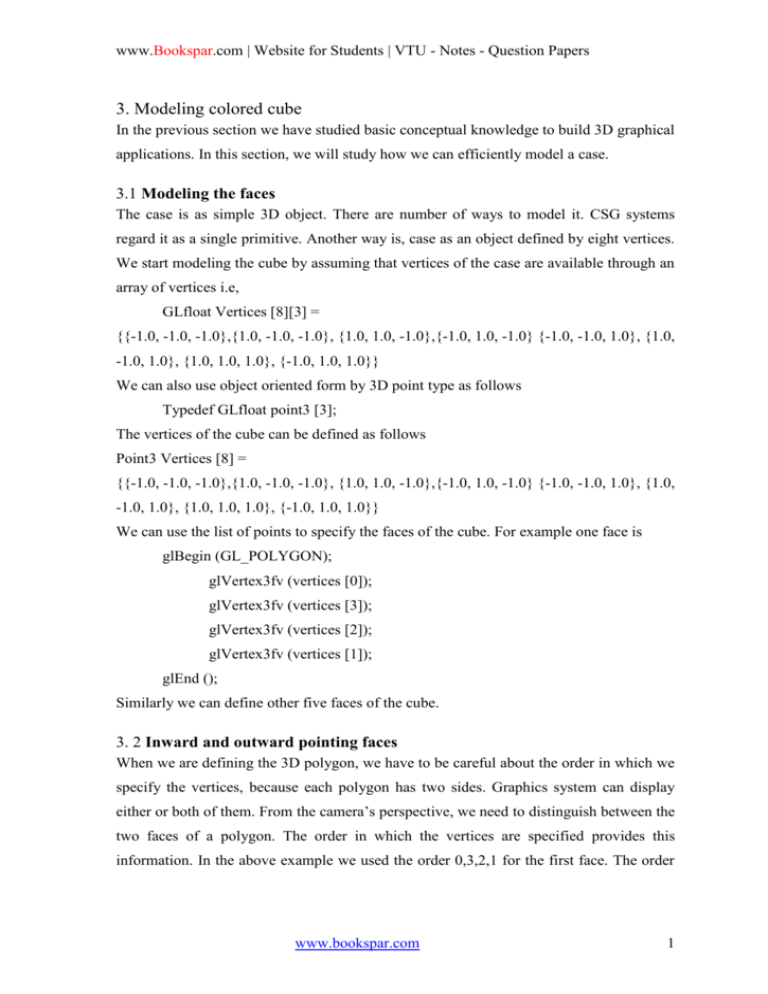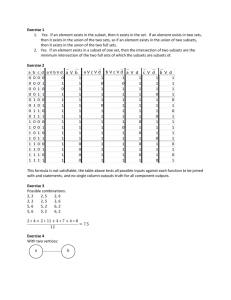Modeling colored cube
advertisement

www.Bookspar.com | Website for Students | VTU - Notes - Question Papers
3. Modeling colored cube
In the previous section we have studied basic conceptual knowledge to build 3D graphical
applications. In this section, we will study how we can efficiently model a case.
3.1 Modeling the faces
The case is as simple 3D object. There are number of ways to model it. CSG systems
regard it as a single primitive. Another way is, case as an object defined by eight vertices.
We start modeling the cube by assuming that vertices of the case are available through an
array of vertices i.e,
GLfloat Vertices [8][3] =
{{-1.0, -1.0, -1.0},{1.0, -1.0, -1.0}, {1.0, 1.0, -1.0},{-1.0, 1.0, -1.0} {-1.0, -1.0, 1.0}, {1.0,
-1.0, 1.0}, {1.0, 1.0, 1.0}, {-1.0, 1.0, 1.0}}
We can also use object oriented form by 3D point type as follows
Typedef GLfloat point3 [3];
The vertices of the cube can be defined as follows
Point3 Vertices [8] =
{{-1.0, -1.0, -1.0},{1.0, -1.0, -1.0}, {1.0, 1.0, -1.0},{-1.0, 1.0, -1.0} {-1.0, -1.0, 1.0}, {1.0,
-1.0, 1.0}, {1.0, 1.0, 1.0}, {-1.0, 1.0, 1.0}}
We can use the list of points to specify the faces of the cube. For example one face is
glBegin (GL_POLYGON);
glVertex3fv (vertices [0]);
glVertex3fv (vertices [3]);
glVertex3fv (vertices [2]);
glVertex3fv (vertices [1]);
glEnd ();
Similarly we can define other five faces of the cube.
3. 2 Inward and outward pointing faces
When we are defining the 3D polygon, we have to be careful about the order in which we
specify the vertices, because each polygon has two sides. Graphics system can display
either or both of them. From the camera’s perspective, we need to distinguish between the
two faces of a polygon. The order in which the vertices are specified provides this
information. In the above example we used the order 0,3,2,1 for the first face. The order
www.bookspar.com
1
www.Bookspar.com | Website for Students | VTU - Notes - Question Papers
1,0,2,3 would be same because the final vertex in polygon definition is always linked
back to the first, but the order 0,1,2,3 is different.
We call face outward facing, if the vertices are traversed in a counter clockwise order,
when the face is viewed from the outside.
In our example, the order 0,3,2,1 specifies outward face of the cube. Whereas the order
0,1,2,3 specifies the back face of the same polygon.
1
0
2
3
By specifying front and back carefully, we will can eliminate faces that are not visible.
OpenGL can treat inward and outward facing polygons differently.
3.3 Data structures for object representation
It is better to use the data structure that separate the geometry from the topology. [The
geometry stands for locations of the vertices and topology stands for organization of the
vertices and edges]. We use a structure, the vertex list (shown in Fig. below) that is both
simple and useful.
The data specifying the location of the vertices contain the geometry and can be stored as
a simple list or array, such as in vertices the vertex list. The top level entity is a cube and
is composed of six faces. Each face consists of four ordered vertices. Each vertex can be
specified indirectly through its index. This can be represented like figure shown above..
www.bookspar.com
2
www.Bookspar.com | Website for Students | VTU - Notes - Question Papers
3.4 The color cube
We can use the vertex list to define a color cube. We can define a function quad to draw
quadrilaterals polygons specified by pointers into the vertex list. The color cube specifies
the six faces, taking care to make them all outward facing as follows.
GLfloatVertices [8] [3] = {{-1.0, -1.0, -1.0}, {1.0, -1.0, -1.0}, {1.0, 1.0, -1.0}, {-1.0, 1.0,
-1.0} {-1.0, -1.0, 1.0}, {1.0, -1.0, 1.0}, {1.0, 1.0, 1.0}, {-1.0, 1.0, 1.0}}
GLfloat color [8] [3] = {{0.0, 0.0, 0.0}, {1.0, 0.0, 0.0}, {1.0, 1.0, 0.0}, {0.0, 1.0, 0.0},
{0.0, 0.0, 1.0}, {1.0, 0.0, 1.0}, {1.0, 1.0, 1.0}, {0.0, 1.0, 1.0}};
void quad (int a, int b, int c, int d)
{
glBegin (GL_QUADS);
glcolor3fv (colors[a]);
glVertex3fv(vertices[a]);
glcolor3fv(colors[b]);
glVertex3fv(vertices[b]);
glcolor3fv(colors[c]);
glVertex3fv (vertices[c]);
glcolor3fv (colors[d]);
glVertex3fv(vertices[d]);
glEnd();
}
Void colorcube ()
{
quad (0,3,2,1);
quad (2,3,7,6);
quad (0, 4,7,3);
quad (1, 2, 6, 5);
quad (4, 5, 6, 7);
quad (0, 1, 5, 4);
3.5 Vertex arrays
Although we used vertex lists to model the cube, it requires many openGL function calls.
For example, the above function make 60 openGL calls: six faces, each of which needs a
www.bookspar.com
3
www.Bookspar.com | Website for Students | VTU - Notes - Question Papers
glBegin, a glEnd, four calls to glColor, and four calls to glVertex. Each of which involves
overhead & data transfer. This problem can be solved by using vertex arrays.
Vertex arrays provide a method for encapsulating the information in data structure such
that we can draw polyhedral objects with only few function calls.
There are three steps in using vertex arrays
(i) Enable the functionality of vertex arrays
(ii) Tell openGL, location & format of the array.
(iii) Render the object.
The first two steps are called initialization part and the third step is called display
callback.
OpenGL allows many different types of arrays; here we are using two such arrays called
color and vertex arrays. The arrays can be enabled as follows.
glEnableClientstate (GL_COLOR_ARRAY)
glEnableClientstate (GL_VERTEX_ARRAY).
The arrays are same as before. Next, we identify where the arrays are as follows.
glVertexPointer (3,GL_FLOAT, 0, Vertices);
glColorPointer (3,GL_FLOAT, 0, COLOR);
The first three arguments state that the elements are 3D colors and vertices stored as
floats & that the elements are contagious in the arrays. Fourth argument is pointer to the
array holding the data. Next, provide information in data structure about the relationship
between the vertices the faces of the cube by specifying an array that holds the 24 ordered
vertex indices for the six faces.
GLubytecubeIndices [24] = {0,3,2,1,2,3,7,6,0,4,7,3,1,2,6,5,4,5,6,7,0,1,5,4};
Each successive four indices describe a face of the cube, Draw the array through
glDrawElements which replaces all glVertex & glcolor calls in the display.
glDrawElements(GLenum type, GLsizei n, GLenum format, void * pointer)
We can draw the cube using two methods
1) for (i=0;,i<6;i++)
glDrawElements(GL_POLYGON,4,GL_UNSIGNED_BYTE, & cubeIndices[4*i]);
2) glDrawElements(GL_QUADS, 24, GL_UNSIGNED_BYTE, cubeIndices);
www.bookspar.com
4








